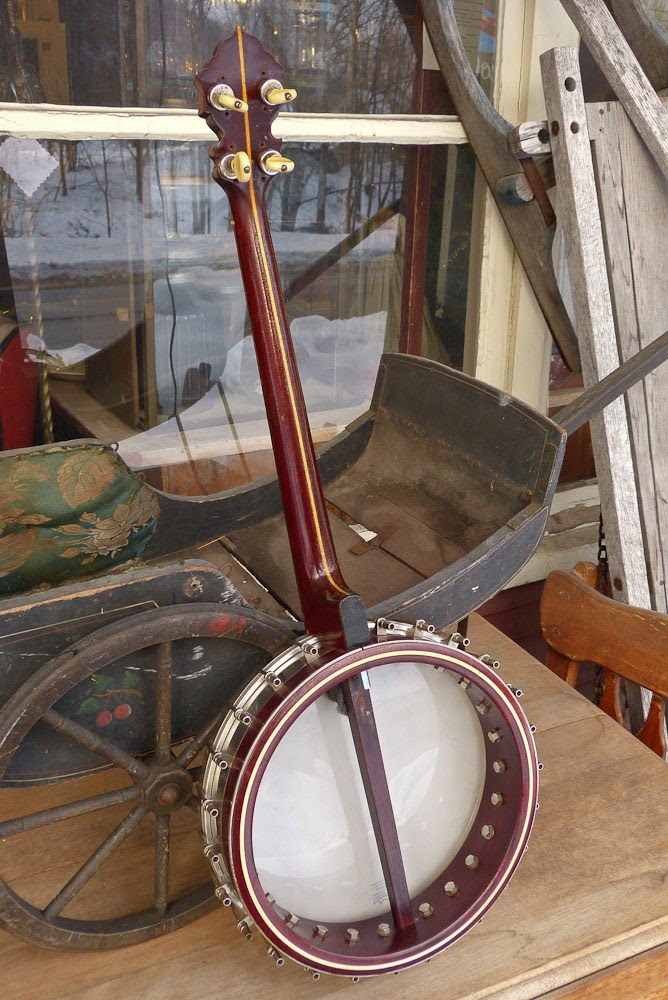c.1920 Langstile IV by Lange Tenor Banjo
Update 2015: I've entirely updated this post.
This nice old Langstile IV is styled somewhere between a lower Orpheum or Paramount model and a mid-level version of the same -- all of which were made by Lange in New York during the "banjo boom." This one dates from the early to mid 1920s and has a "mid" scale length of 22" on a big 11 1/2" rim. It's got a big old round hoop-style tonering suspended on little "nibs" that protrude from the outer "shell" tonering bit that the rim's shoes are mounted over. This is a lot like an Orpheum ring and gives it a very typical "Lange" sort of sound for the period: loud, punchy, gutsy, and full-on.
I'd previously (in 2012) done a general going-over including a fret
level/dress, added some nice vintage planetary tuners, did a setup, and made
it ship-shape and a hot-to-trot player. Since then it's been playing
elsewhere but I just recently (Jan 2015) got it back here and it came
back in with a loose dowel and a need for a new bridge and fresh setup. I
reset the dowel and converted the neck brace from a friction-set type
to a Gibson-style hanger bolt type. This relieves the dowel from
carrying all the "mating" tension of neck to rim and makes a more secure hold on the neck to keep it far more stable while banging around at gigs.
I also set it up with medium-gauge (Langes like heavier gauges) CGDA "standard" tuning strings which results in a good, tight, full sound (for a banjo). You can definitely hear the tone of this thing creeping out of old early jazz cuts.
The inlaid metal and pearl is gorgeous. This has a 3-piece maple neck with dyed-maple fretboard and headstock veneer. The nut is newer and bone.
It plays spot-on with a straight neck and 1/16" action at the 12th fret.
Pretty pearl here, too! The binding on the board appears to be fiberloid or dark-stained wood. I like the original side dots as well as the medium D-shaped neck. It fits the hand like a glove for fast work.
The replacement frosted-top Remo head is holding up well and the adjustable Lange-patent tailpiece is a great thing to have on hand. I used a parts-bin bridge and compensated it for CGDA or DGBE stringing.
Don't you love all that hardware against the pretty crimson finish?
The "rim cap" on the bottom edge has a cool inlaid strip of celluloid or something similar.
The vintage Grover geared tuners are a welcome replacement for the usual friction pegs these tend to come with. At some point, Paige tuners had been installed, though.
Disregard the steel wool ball: it's just acting like an overtone mute.
Do note the new "neck brace" -- the big old hex nut -- as it attaches the neck to the pot securely. I've installed a big old hanger-bolt "Gibson fashion" into the heel and passed it through the rim so this hex nut tightens the neck itself to the pot rather than the dowel pulling the neck to the pot. This is far more stable than the original brace which, obviously, proved inadequate "in regular use." It's not as pretty a solution but it sure is rugged. I've done this to a number of old banjos and they're all a lot more stable "in service" than a traditional wood-shim neck brace (which customers, inevitably, get confused about anyway in terms of maintaining them).
The tail has to be snugged over a little for a direct string path. This is nothing new if you're used to old jos, however...
All that rim hardware is original and in tidy condition.
















Comments